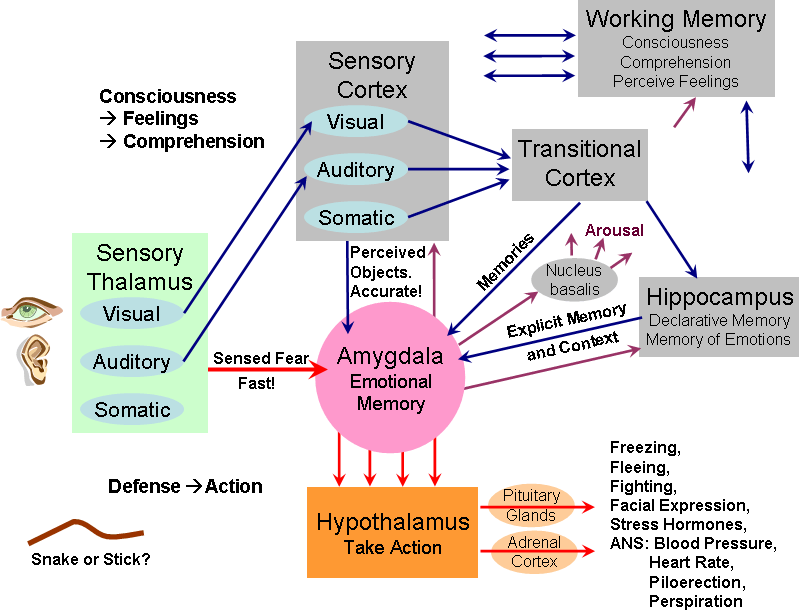|
Our Emotional Brain
Defend, then Comprehend
Our brains evolved first as survival mechanisms. Only eons later did we develop
our cognitive abilities. As a result, when we are faced with a threat we sense
and act first and only later do we consciously notice, decide, and reflect.Definitions
- The many paths through our mind and body that help us respond to life's
important events
Emotional Pathways
Joseph LeDoux has dedicated most of his career to tracing the paths emotions
take through our brains. He has concentrated his efforts on studying the paths
fear takes through our brains and bodies. The following diagram provides a
high-level view of those paths.

There are two basic pathways. The fastest is designed to take immediate
defensive action, focusing on bodily responses. This happens unconsciously. The other path is a slower but more thoughtful one through our
consciousness that allows us to become aware, feel the emotion, and comprehend its meaning.
Events begin with our senses: sight, hearing, smell, taste, and somatic
feedback from throughout our body, including touch. The fast track passes any
sense of fear directly to our amygdala for action. The
amygdala is “emotions central” within our brain. It is connected through our
hypothalamus
is “emotions central” within our brain. It is connected through our
hypothalamus ,
pituitary glands, and adrenal cortex directly to our bodies. This initiates
immediate physiological actions including freezing; muscular preparation for
fleeing, or fighting; the distinctive facial expression of fear; stress hormones
are released throughout our body; and the Autonomic Nervous System is energized
to activate increased blood pressure, increased heart rate, piloerection (goose
bumps), and sweating. If we suddenly see a long thin cylindrical object, this
path prepares our bodies to defend against a snake attack even before we become
conscious it is a snake. ,
pituitary glands, and adrenal cortex directly to our bodies. This initiates
immediate physiological actions including freezing; muscular preparation for
fleeing, or fighting; the distinctive facial expression of fear; stress hormones
are released throughout our body; and the Autonomic Nervous System is energized
to activate increased blood pressure, increased heart rate, piloerection (goose
bumps), and sweating. If we suddenly see a long thin cylindrical object, this
path prepares our bodies to defend against a snake attack even before we become
conscious it is a snake.
In parallel, the sensory thalamus passes the sensory information to the
sensory cortex for analysis that results in perception. Here the sensed
cylindrical object gets perceived as either a harmful snake or a harmless stick
and is then represented by the corresponding mental symbol.
The transition cortex combines the sensory information with long term memories
to form a still more detailed and precise appraisal of what has been
encountered. Does this sound and smell more like a stick or a snake? Is a snake
or a stick dangerous? Finally, detailed long-term declarative memories from the
hippocampus are accessed to aid in the appraisal. What happened the last time I encountered
one? If it is a dangerous snake, the body has already prepared for action and
the defensive strategy can continue. If it is a stick, you can decide to relax
and catch your breath. However, in any case your body has tensed up from the
fast-track defensive actions that have already occurred and you also become
conscious of feeling fear.
are accessed to aid in the appraisal. What happened the last time I encountered
one? If it is a dangerous snake, the body has already prepared for action and
the defensive strategy can continue. If it is a stick, you can decide to relax
and catch your breath. However, in any case your body has tensed up from the
fast-track defensive actions that have already occurred and you also become
conscious of feeling fear.
Consciousness is our awareness of what is in working memory—the activated
long-term memories, short-term memories, and the associated decision processes. The amygdala alerts the brain as well as the body. It arouses
the cortex and focuses the
attention of working memory, sharpens the senses, and hastens retrieval of
long-term memories relevant to this emotion or context. Working memory assesses
all of this and makes us conscious that we feel afraid. Feelings arise when the
activity of specialized emotional systems get recognized by our consciousness.
Various types of memories are stored using a variety of different systems
within the brain. Long term declarative memory, including the memory of an
emotion, is stored in the hippocampus. But emotional memory, the raw
recollection that something significant happened before, is stored below the
level of consciousness in the amygdala. These are retrieved independently and
perceived differently by us.
Quotations
- “Our civilization is still in a middle stage, scarcely beast, in that it
is no longer guided by instinct, scarcely human in that it is not yet wholly
guided by reason.” ~
Theodore Dreiser

References
The Emotional Brain ,
by Joseph E. Ledoux ,
by Joseph E. Ledoux
Mapping the Mind ,
by Rita Carter ,
by Rita Carter
Descartes' Error: Emotion, Reason, and the Human Brain , by Antonio Damasio , by Antonio Damasio
Emotional Intelligence: Why It Can Matter More Than IQ , by
Daniel Goleman , by
Daniel Goleman
|
Fear, Sadness, Anger, Joy, Surprise, Disgust, Contempt,
Anger, Envy, Jealousy, Fright, Anxiety, Guilt, Shame, Relief, Hope, Sadness, Depression, Happiness,
Pride, Love, Gratitude, Compassion, Aesthetic Experience,
Joy, Distress, Happy-for, Sorry-for, Resentment, Gloating, Pride, Shame, Admiration, Reproach,
Love, Hate, Hope, Fear, Satisfaction, Relief, Fears-confirmed, Disappointment, Gratification,
Gratitude, Anger, Remorse, power, dominance, stature, relationships |
